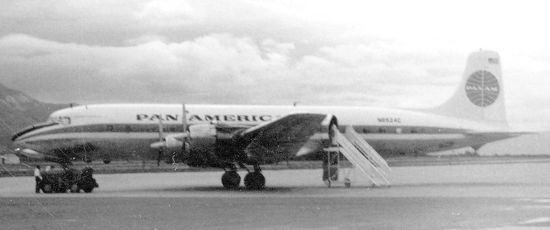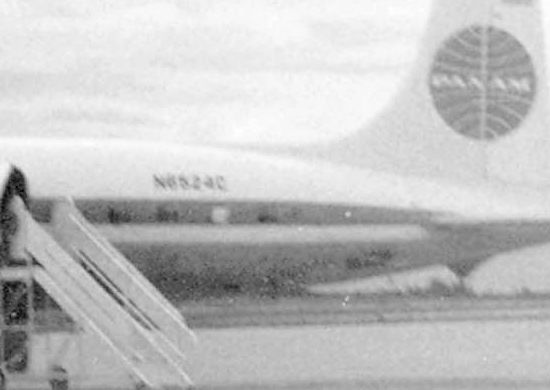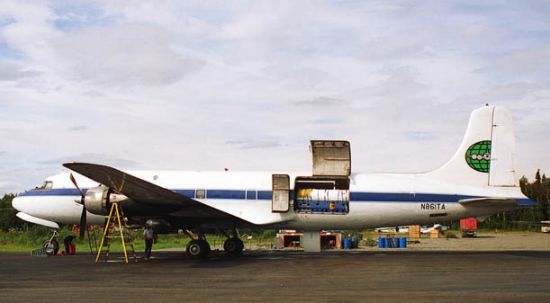|
||||||||||
|
|
||||||||||
|
||||||||||
|
|
||||||||||

After researching our reference data on these two aircraft, it does indeed appear to be difficult to visually differentiate between the DC-6 and DC-7. The DC-7 was slightly bigger and used different engines, but one source states "...externally the DC-7 appeared little different from the DC-6B."
The most obvious clue is that the DC-7 used four-bladed propellers on its engines while the DC-6 had only three blades. Unfortunately, the photo you've provided is not at a very good angle to see the propellers. While it looks like the plane may have three blades, it is at best inconclusive.
Another possible item to look for is whether or not there is a large 7 painted on the vertical tail, since many airlines operating the DC-7 included a large "7B," "7C," or "Super 7" in that location. The picture obviously does not display this feature, indicating that it may be a DC-6, but that observation is again inconclusive.
Finally, we reviewed the list of operators for both the DC-6 and DC-7 hoping to determine whether Pan Am operated only one type. Unforunately, Pan Am purchased both aircraft, so there's no help there either.

Luckily, that picture does provide one key piece of information--the registration number, N6524C. Researching that number quickly turned up a wealth of information on this rather historic aircraft. The plane was a DC-6 delivered to Pan Am World Airways in 1952 and named the Clipper Pocahontas. The aircraft remained in service with Pan Am until 1960 when it was leased to Capital Airlines for a year, being returned in 1961. The plane was then leased again for a year to Aerovias Panama on 19 May 1962, at which point it was re-designated HP-343. In January 1967, the aircraft was sold to Pacific Airmotive Corporation.
Shortly thereafter, the aircraft was upgraded to the DC-6A/B standard and purchased by the US Air Force in 1967. It was later transferred to the Chilean Air Force who gave it the new tail number 987. There the plane remained for over a decade until bought by the Atlas Aircraft Corporation in February 1982 and re-registered as N861TA. While stored at Opa Locka, Florida, the aircraft again changed ownership to Freedom International Corporation in May 1984. In June of that year, the plane was leased by Universal Airlines.
Northern Pacific Transport bought the DC-6 in October 1989 and tranferred the aircraft to Alaska. By 1995, it was operated by Woods Air Fuel. A photo of the plane, still carrying registration N861TA and in the livery of Woods Air Fuel, was taken at Palmer, Alaska, in 1995 and is shown below. The open cargo hatch provides a view of the tanks used to ferry fuel to remote communities in Alaska.

The plane remained in operation hauling fuel until 2 January 1998 when it crashed during an aborted takeoff at McGrath, Alaska. You can see what a varied life this classic aircraft led, taking it from Alaska to Panama to the US Air Force to Chile to Florida and, somewhat fittingly, back to Alaska to round out her nearly 50-year career.
After providing this answer, Brian informed us that the now identified photo is to be published in an historical
story on the history of Juneau, Alaska.
- answer by Jeff Scott, 22 June 2003
Read More Articles:


|
Aircraft | Design | Ask Us | Shop | Search |

|
|
| About Us | Contact Us | Copyright © 1997-2023 | |||
|
|
|||